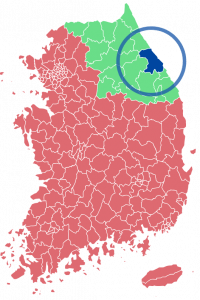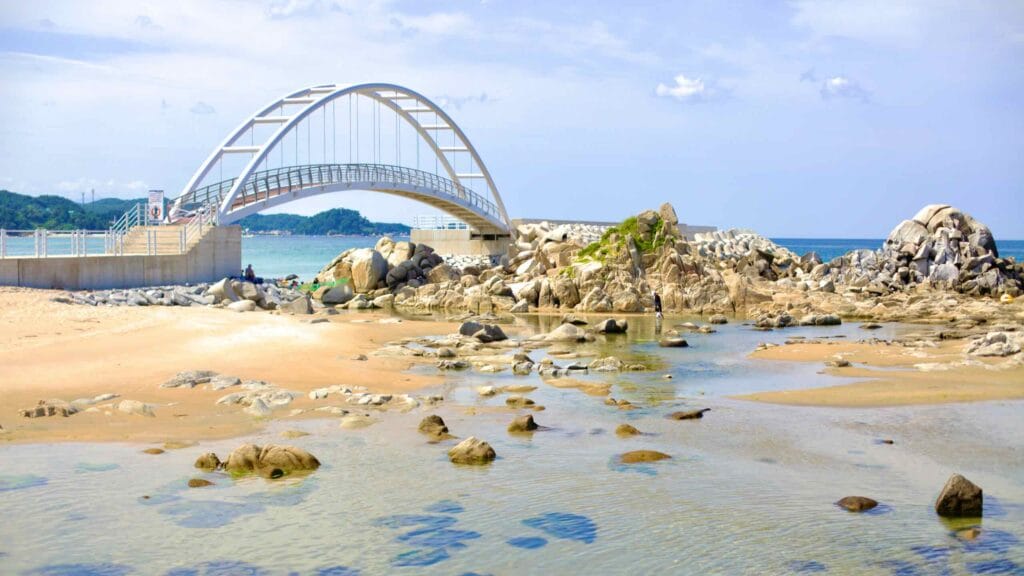
Gangneung City
Gangneung City (강릉시; map) sits in northern South Korea’s Gangwon State. The municipality features a unique blend of coastal and mountainous landscapes, marked by the Taebaek Mountain Range and the East Sea. The city is a harmonious mix of natural beauty and cultural heritage.
Gangneung’s geographical setting has significantly influenced its cultural and historical development. The proximity to the sea has fostered a rich maritime heritage, while the surrounding mountains have shaped a distinct lifestyle steeped in nature. This combination has led to a diverse array of attractions, from serene beaches to rugged mountain vistas.
The city is also a cultural hub along Korea’s east coast. Its history is visible in well-preserved traditional architecture like Gyeongpodae Pavilion and Ojukheon House, and vibrant cultural events, such as the Gangneung Danoje Festival, which reflects the region’s heritage.
Gangneung’s economy thrives on a blend of tourism, driven by its scenic and cultural assets, and agriculture, with local specialties like persimmons.
In 2018, Gangneung hosted part of the Winter Olympics. The city built state-of-the-art facilities, including the Gangneung Hockey Centre and Gangneung Oval in Olympic Park near Gyeongpodae. The facilities are still in use and open to the public.
Coastal Gangneung
Coastal Gangneung stretches along the East Sea. It is a significant part of the city’s identity, with most of Gangneung’s population living on the coast. The coastline is not only a natural wonder but also a vital component of daily life for the residents.
The region’s beaches, ranging from the bustling Gyeongpo Beach to the tranquil Anmok Beach, are popular destinations for locals and tourists. They offer an array of seaside activities, from surfing to viewing the sea from Gangneung Coffee Street. Like other east coast districts, Gangneung boasts an impressive array of seaside restaurants, serving spicy soup, raw fish, and home-ground tofu.
The coastal area is also a hub for cultural events that reflect the maritime heritage of Gangneung. Key cultural events include:
- Gangneung Danoje Festival (강릉단오제), recognized by UNESCO, embodies the region’s maritime heritage. Celebrated for over a thousand years, it blends shamanistic rituals with local customs, symbolizing the community’s connection with nature. The festival features traditional mask dances, folk games, and ceremonies to wish for prosperity and good health, preserving the ancient cultural fabric of Gangneung.
- Gyeongpo Summer Sea Festival (경포썸머페스티벌), held at Gyeongpo Beach, is a vibrant event that transforms the beach into a center of music, arts, and beach activities. The festival’s highlights include live radio shows, K-pop concerts, and various beach sports.
Gangneung Ports
Gangneung City is home to several ports that play a significant role in the region’s economy and culture. Most of Gangneung’s population lives along the coast, and these ports are central to their way of life.
- Jumunjin Port (주문진항; map): Established in June 1927, Jumunjin Port is a major harbor in the Yeongdong region. Not a trade port, it focuses on fishing and coastal activities. Known for its rich variety of seafood, especially squid, it also played a notable role during the Korean War. The port has undergone improvements, including installing a seawater exchange breakwater in the 1990s, significantly enhancing water quality.
- Gangneung Port (강릉항; map): Also known as Anmok Port, it opened in 1927 and has been pivotal in regional maritime activities, particularly in fishing. Despite its non-trade status, the port achieved a significant cargo handling capacity by 2009, mainly dealing in silica sand.
- Simgok Port (심곡항; map): Nestled in a deep valley, Simgok Port is known for its tranquil setting and abundant marine life. The port’s coastal cliffs offer stunning views, and the recent construction of a scenic coastal road has enhanced its appeal as a tourist destination. It is part of the “three most beautiful ports in Gangwon-do,” known for its picturesque winter landscape and a popular spot for sunrise viewing.
Food
Exploring the culinary landscape of Gangneung City is a journey through unique local specialties, reflecting the area’s cultural and geographical diversity. Here are some must-try dishes:
- Soft Tofu Stew (순두부찌개; Sundubu Jjigae): Originating from the Chodang Neighborhood in Gangneung, these dishes, such as Soft Tofu Stew, Mixed Tofu (모두부; Modubu), Tofu Trio (두부 삼합; Dubu Samhap), and Fried Tofu (두부 튀김; Dubu Twigim), are notable for using sea water, giving them a distinct depth and a healthy flavor.
- Spicy Noodle Soup (장칼국수; Jang Kalguksu): A staple in Gangwon Province, this noodle soup is spiced with red chili paste (고추장; gochujang) or soybean paste (된장; doenjang), offering a savory experience.
- Raw Fish Soup (물회; mulhoe): A popular choice in Gangneung, this dish features fresh seasonal sashimi in a chilled broth seasoned with plum extract and pear juice.
- Potato Dough Balls & Potato Pancake (옹심이 & 감자전; ongsimi & gamjajeon): Showcasing Gangwon’s famous potatoes, these small potato dough balls and pancakes are a go-to choose for breakfast.
- Braised Fish and Radish (생선찜; Saengseon Jjim): Fish like Pollock (도루묵; Doraemon) and radish are braised, offering succulent flavors and a savory taste.
- Spicy Seafood Noodle Soup (짬뽕; Jjamppong): Gangneung’s Gyodong Jjamppong is among the top jjamppong variants in the country, known for its spicy broth and diverse seafood.
- Buckwheat Noodles (막국수; Makguksu): A signature dish of Gangneung, these cold buckwheat noodles are served with various garnishes and seasoned with either a spicy sauce or a refreshing radish water kimchi (동치미; Dongchimi) broth.
Eight Scenic Sights of Gangneung
Gangneung City offers a smorgasbord of picturesque and culturally significant sights. These highlights showcase the city’s diverse landscapes and rich historical heritage. Here are the eight must-visit scenic sights in Gangneung:
- Gyeongpodae Pavilion (경포대; map): This renowned pavilion, celebrated for its panoramic views of Gyeongpo Lake and the East Sea, epitomizes the harmonious blend of natural beauty and architectural elegance. It’s a popular spot for watching the moon’s reflection on the lake, a view so stunning it’s mentioned in ancient Korean literature.
- Ojukheon House (오죽헌; map): The historic birthplace of the famous scholar Yulgok and his mother Shin Saimdang, Ojukheon, preserves a slice of Joseon era life (1392 ~ 1897). Getting its name from the black bamboo that grows on the property, Ojukheon showcases traditional upper-class Joseon architecture and artifacts.
- Sogeum River Valley (소금강계곡; map): Sitting in Odaesan National Park, Sogeumgang is famed for its extraordinary rock formations and picturesque vistas such as Mureung Valley.
- Jeongdongjin (정동진; map): Dating back to the Joseon Dynasty, Jeongdongjin was initially a site for royal ceremonies honoring the Dragon King of the seas. It developed into a fishing village, then an area, famed for its role in the popular 90s drama “Sandglass.” It’s now a bustling tourist destination, drawing visitors to its picturesque train station and the breathtaking sunrises over the East Sea.
- Seongyojang (선교장; map): This well-preserved noble house from the late Joseon era illustrates fine traditional Korean architecture. The compound includes the elegant Yeolhwadang Pavilion and Hwallaedong House, surrounded by picturesque gardens and reflective ponds.
- Daegwallyeong Natural Recreation Forest (대관령자연휴양림; map): A sanctuary of pine trees, this forest represents the unspoiled beauty of Gangneung. Its tranquil paths and fresh mountain air provide an escape from the city, ideal for hiking and meditation.
- Gangneung Danoje Festival (강릉단오제): Celebrated for centuries, this UNESCO-listed event is a vibrant display of local customs, including traditional music, dance, and rituals. The festival serves as a living museum of Korean folk culture.
- Gyeongpo Provincial Park (경포도립공원; map): This coastal park is a haven of tranquility and beauty, featuring the Gyeongpodae Pavilion, sandy beaches, and lush greenery. It’s an ideal spot for leisurely walks, picnics, and enjoying the scenic blend of forest and sea. It also holds many of Gangneung’s featured attractions, including Ojukheon, Gyeongpodae Pavilion, Olympic Park, and a handful of museums.
Inland Gangneung
Inland Gangneung offers a stark contrast to the coastal areas with its rich tapestry of rugged terrain and cultural heritage. Dominated by the Taebaek Mountain Range, this region is a mosaic of dense forests, serene valleys, and historical depth.
The Taebaek Mountains, serving as the backbone of the Korean Peninsula, are home to prominent peaks like Odaesan and Dutasan. They provide challenging and scenic hiking trails. Within Odaesan National Park, a haven for biodiversity, lies Woljeongsa Temple. This cultural sanctuary dates back to the 7th century. The temple, surrounded by ancient fir trees, leads to the picturesque Birobong Peak Trail, offering panoramic views and a peaceful retreat.
The Seongyojang Trail leads to the historic Seongyojang House, a well-preserved example of Joseon era architecture. This nobleman’s residence, with its intricate designs and tranquil gardens, provides a window into Korea’s aristocratic past. The Seongyojang Trail also meanders through ancient forests, adding a touch of historical and natural serenity.
Pristine valleys like Sogeum River Valley also adorn inland Gangneung. Renowned for its striking rock formations, clear streams, and leisurely hiking trails, it hosts Guryong Falls.




